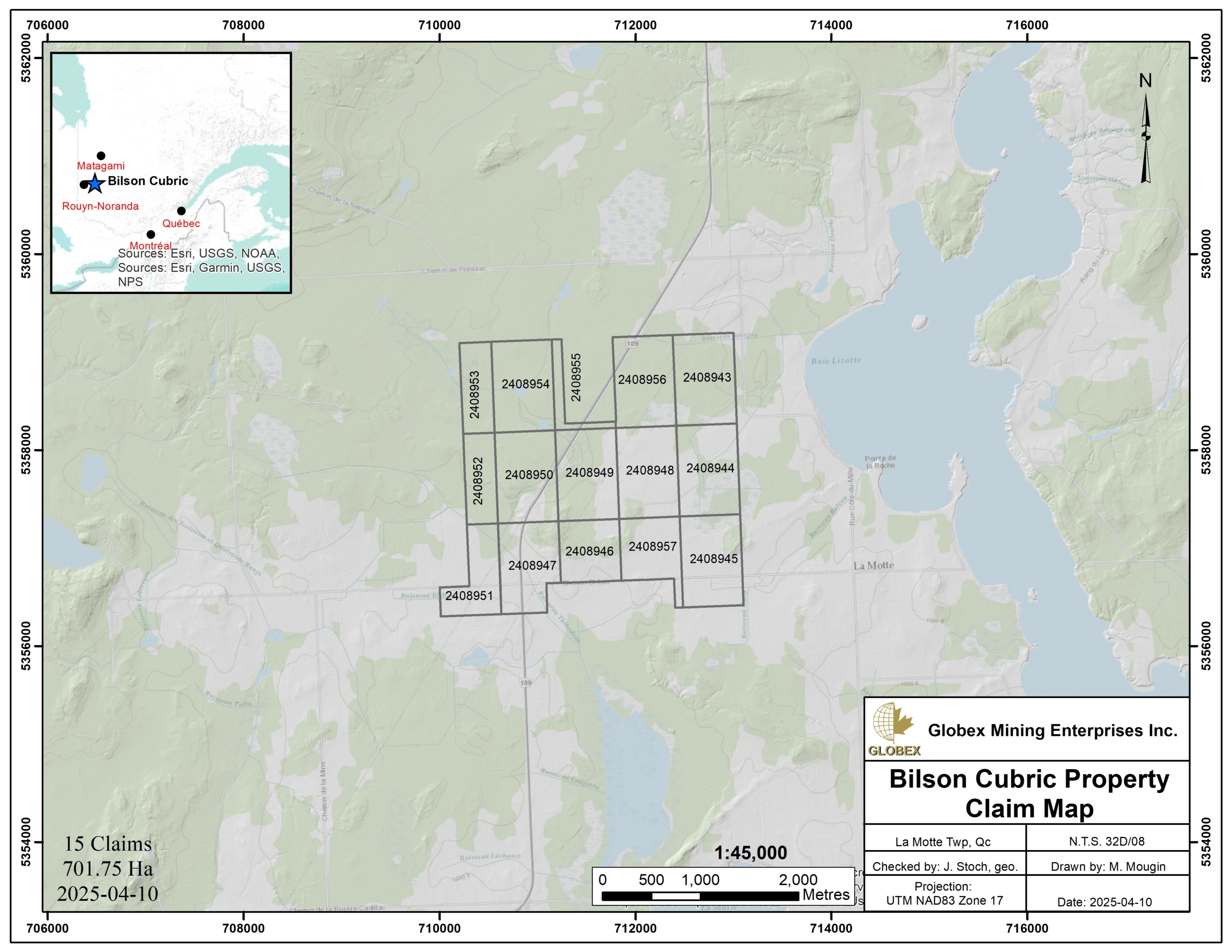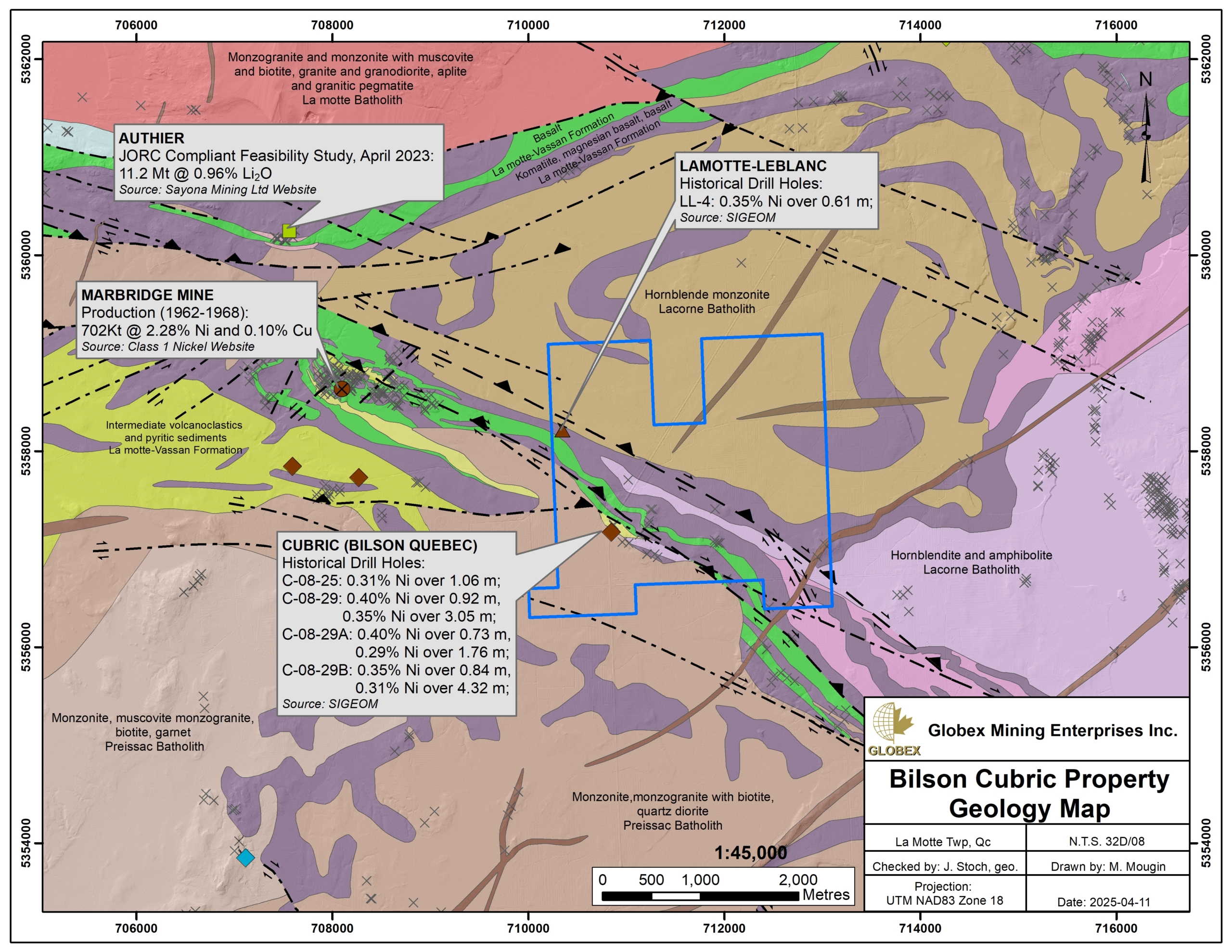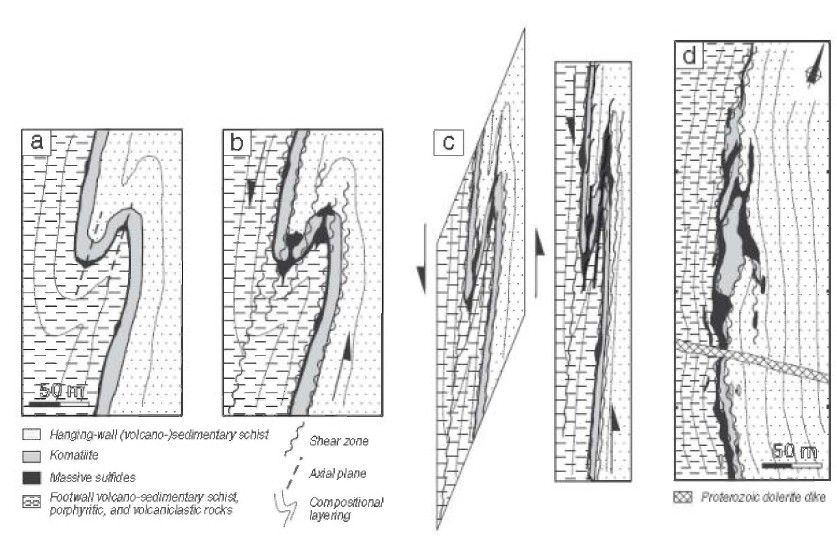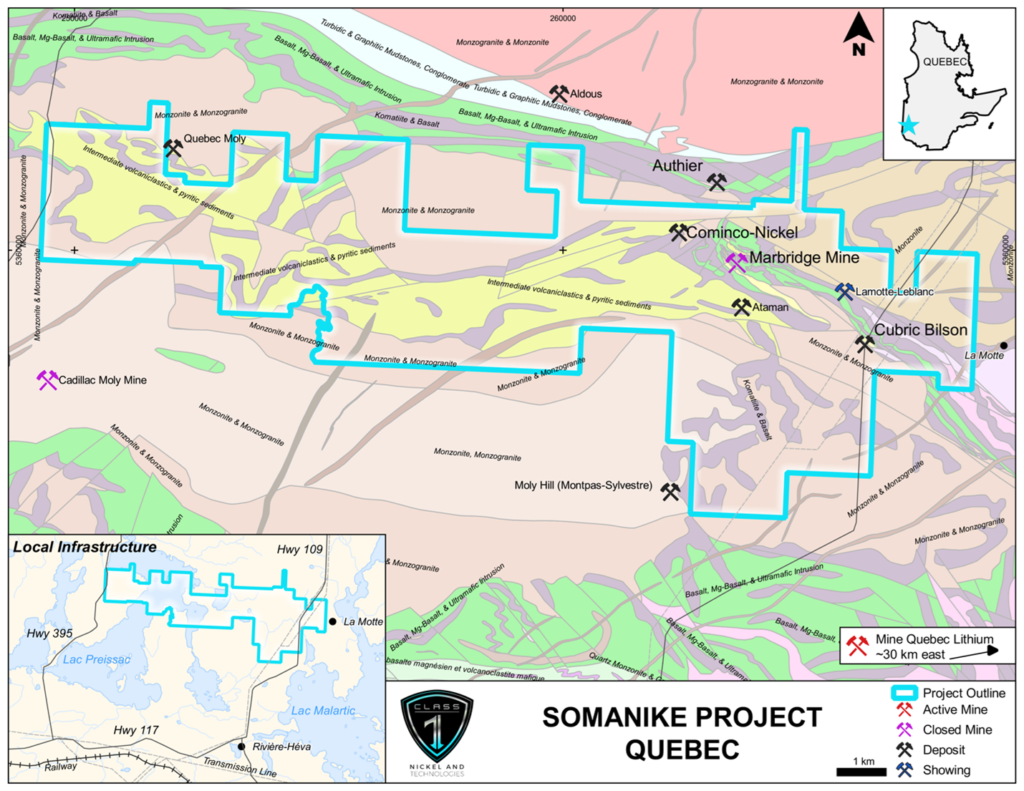Bilson Cubric
Location, Access, Description
The Bilson Cubric property consists of 15 mining claims covering an area of 701.75 Ha in the Abitibi Township of Quebec Province, approximately 25 km south of Amos (Qc) and 30 km northwest of Val-d’Or (Qc). The claims are now wholly owned by Class 1 Nickel and Technologies Ltd., but Globex retain a 2% Gross Metal Royalty (GMR).
The property is accessible via the 109 Provincial Road linking Val-d’Or to Amos. These towns can provide remote workers with all food and sleep facilities as well as shops and contractors. A Hydro power line crosses the property from northeast to southwest.
Geology and Mineralization
The information below was transcribed from D’Amours, 2009 (GM64514) and Lafrance et al., 2015 (MB2015-12).
Regional Settings
The Bilson-Cubric property is located within the Abitibi Subprovince of the Canadian Shield. The Abitibi Subprovince is an Archean greenstone belt which hosts some of the richest mineral deposits of the Superior Province. It is divided into two distinct parts (Chown et al., 1992): the South Volcanic Zone (SVZ) and the North Volcanic Zone (NVZ), separated by the Destor-Porcupine-Manneville fault (Mueller et al., 1996). The property lies within the Malartic Group (Dimroth et al., 1982) which constitutes the eastern portion of the SVZ in the province of Quebec.
The Malartic Group is a volcano-sedimentary assemblage characterised by the predominance of komatiitic and tholeiitic lava flows. It covers an area of about 2,300 km square from just north of the town of Val D’Or up to the Destor-Porcupine Tectonic Zone. Ultramafic rocks are mainly present in the SVZ (Dimroth et al., 1982) and are interpreted as being derived from a mantle plume (Mueller et al., 1996). The Malartic Group is divided in three formations which are from bottom to top: (1) the Lamotte-Vassan Formation, (2) the Dubuisson Formation, and (3) the Jacola Formation (Champagne et al., 2002). This volcano-sedimentary assemblage is crosscut by pre to post-tectonic plutons and by Ne-SW Proterozoic dykes (Desrochers et al., 1996).
Rocks of the area were strongly deformed and present evidences of a moderately east-dipping stretching lineation. The principal structure of the region is the Lamotte Anticline (Imreh, 1984) an overturned fold inclined to the south. Regional metamorphism is at the amphibolitic grade. At the Marbridge mine, it is possible to observe the tectonic complexity of the region’s history (Imreh, 1984; Pilote, 2000).
Property Geology
The Bilson-Cubric property lies at the stratigraphic base of the Malartic Group (Alsac and Latulippe, 1979) and is underlain by rocks of the Lamotte-Vassan Formation (LVF). The LVF consists largely of komatiites with lesser intercalated basalts and minor felsic volcanoclastites and undifferentiated metasediments. This largely ultramafic sequence is intruded by three major batholiths (ET84-03; RG160; MM82-04) : the La Motte, Preissac and Lacorne Batholiths, respectively of monzogranitic, granitic and granodioritic compositions. The LVF and granitoid plutons are crosscut by Proterozoic diabase dykes.
The polarities observed on the field suggest that the base of the Marbridge mine area is represented by fragmentary pyrrhotite- and pyrite-rich felsic volcanics and biotite-hornblende schists (MB2015-12). This interpretation is compatible with the formation of an early volcanogenic system later overlain by a komatiitic volcanic sequence.
The dominant structural feature of the area is the Marbridge shear corridor which crosses the entire property from NW to SE.
Regional Metallogeny
The area of the Bilson-Cubric property hosts several occurrences of nickel mineralization associated with komatiites (Kambalda-type mineralization). This type of deposit is mainly emplaced at the base of the komatiitic flow due to the difference in density between the denser sulfide liquid and the less dense silicate liquid (Huppert and Sparks, 1985; Lesher et al., 1984).
Deformation causes a change in the geometry of the deposit. Massive sulfides tend to remobilize and concentrate in fold hinges and shear zones, while mineralized lenses use to boudinate along the fold flanks (MB2015-12).
The Marbridge mine is located about 2 km west of the Bilson-Cubric Property. The Falconbridge Nickel reported production of 702,366 tons grading 2.28% Ni and 0.10% Cu from 1962 to 1968 (Class 1 Nickel website) from four mineralized mineralized lenses, prior to being placed on care and maintenance in 1968. Mineralization is commonly found in komatiite and it is associated with a shear zone or massive sulfide veins. The lithologies are affected by tight folding with a NW-SE structural grain. Near mineralized zones, ultramafic rocks show serpentine, talc and tremolite-actinote alteration.
The Authier Lithium deposit of Sayona Mining Ltd. is located about 2.8 km northwest from the Bilson-Cubric Property, within mafic and ultramafic volcanics of the La Motte-Vassan Formation, south of the La Motte Batholith. JORC compliant Proven and Probable Reserves of 11.2Mt @ 0.96 % Li2Ohave been calculated (April 2023).
Property Mineralization
The property hosts the Cubric (Bilson Quebec) showing which have been discovered in 1957 by prospection. It consists of two NW- to N-S oriented horizons hosting sulphide mineralization in komatiites. Sulphides are namely pyrite, pyrrhotite, pentlandite, chalcopyrite and magnetite. Mineralization is disseminated to massive and it is included within shear zones (GM64026). Best assays in historical data include up to 3.98% Ni, 0.93% Cu and 7.8 g/t Ag over 0.60 m in channel-sampling (GM64026), and up to 5.24% Ni and 1.47% Cu over 2.17 m in DDH (GM59471).
History
The Bilson-Cubric property has seen sporadic mineral exploration since 1957 when a nickel showing was discovered at surface 411 m north and 38 m west of the southeastern corner of lot 20, range IV. This discovery occurred shortly after the discovery of the Marbridge Nickel Deposit (historical production of 703,027 tonnes grading 2.28% Ni for a total of 12,000 tonnes Ni and 543 tonnes Cu), some 3 km along strike to the northwest. Continental Mining Company soon optioned the property and conducted trenching and stripping over the showing area along with magnetometer, electromagnetic and resistivity surveys. Thirteen short diamond drill holes, totalling 87 m, were completed and a small surface nickel zone was outlined (GM06706).
Bilson Quebec Mining Company optioned the ground in 1959 and implemented a varied exploration program (GM09892). In 1967, Falconbridge Mining became a joint venture partner with Bilson and extensive ground work was undertaken. Drilling on the property during this period consisted of 56 holes totalling 5,116 m.
In 1979, Falconbridge Mining conducted an I.P. survey over a large property which encompassed some of the present Bilson-Cubric property. Several companies and/or individuals held the property during the following years, but only limited work (consisting predominantly of compilations) was performed in an attempt to increase the understanding of the Bilson-Cubric Zone (±200,000t grading 0.85% Ni, historical and non NI 43-101 compliant).
A magnetic survey was undertaken by Jack Stoch Geoconseils in January 1996 on lot 20 in the area of the known economic type sulphides (GM53710).
In 2000 Globex and its former partner Aurogin Resources flew a detailed Aerotem Survey (EM & MAG) over the property and carried out detailed prospecting and beep mat surveys over anomalous areas (GM59473). Globex also stripped the Bilson-Cubric showing and mapped and channel sampled the exposed sulphides. Assays up to 4.15% nickel and 1.15% copper over 3.39 metres were encountered with anomalous platinum and palladium values from remobilised mineralization. Previous sampling of loose mineralized rock from previous blasting of trenches returned up to 4.6% nickel and up to 1.5 g/t of combined platinum, palladium and rhodium as well as up to 0.96% cobalt. In early 2001 one follow-up hole was drilled on lot 20 in the area of the nickel zone (GM59472).
Between 2007 and 2008 Bull’s Eye exploration drilled 10 holes totalling 366 m on the property (GM64026) as part of an option agreement with Globex. This drilling was aimed at duplicating some of the old drilling carried out by Falconbridge. The geology correlated fairly well with the historical drilling and intersected zones of massive to semi-massive sulphides. The best results included 0.35% Ni over 3.05 m and 0.40% Ni over 0.73 m.
Bull’s Eye also further stripped the Bilson-Cubric showing and dug a 50 m trench. This work revealed a zone of semi-massive to massive sulphides starting at the junction of two shear zones. A loose block found in the trenching rubble assayed 7.99% Ni.
Later in 2008 Diagnos Inc. used its CARDS (Computer Aided Resource Detection System) to generate a Ni and Cu exploration model for the Bilson-Cubric property (GM64514). The system identified a target on the current property which has yet to be investigated.
In 2011, Geotech Ltd. carried out a Helicopter-Borne EM and Aeromagnetic survey on the Lacorne Property for Rock Tech Lithium Inc. (GM66216). This survey englobed the entire Bilson-Cubric Property and confirmed the presence of a large strongly magnetic feature crossing the central part of the property in a NW-SE orientation.
Resources and Potential
Class 1 Nickel is currently exploring the Bilson-Cubric Property as part of its Somanike Nickel-Copper Project, a large property which also includes the old Marbridge Mine.
On February 8, 2023, the Company announced the completion of 40 drill holes (16,510m) at Somanike. Diamond drilling has intersected sulphide mineralization in 23 drill holes. Mineralization is within and, in close proximity to ultramafic rocks. The host rocks are komatiitic flows and can be correlated with the horizons in the mine sequences at Mine 1, Mine 2, Mine 3 and Mine 4.
Drilling has confirmed that Mine 1 is in a separate stratigraphic/structural sequence from Mine 2, Mine 3 and Mine 4 that are in the hanging wall to Mine 1.
Down hole time domain (BHEM) geophysical surveys on holes drilled to date have identified multiple off-hole anomalies for follow-up.
Drone mag and LIDAR surveys have been completed over the main Marbridge area. These have identified magnetic trends that demonstrate both definition of known nickel-bearing ultramafic rocks and the significant continuation of ultramafic rocks into under-explored areas.
The Company’s primary objective is to make a major discovery of high-grade magmatic nickel sulphides in an environment of known nickel mineralization with significant opportunity for new discoveries.
Multiple geophysical exploration targets exist within the Marbridge Mine area and regionally within the Somanike Project.
Effective depth of exploration from the previous drilling is limited to the top 200 m in the areas explored outside the vicinity of Marbridge #1 Mine.





